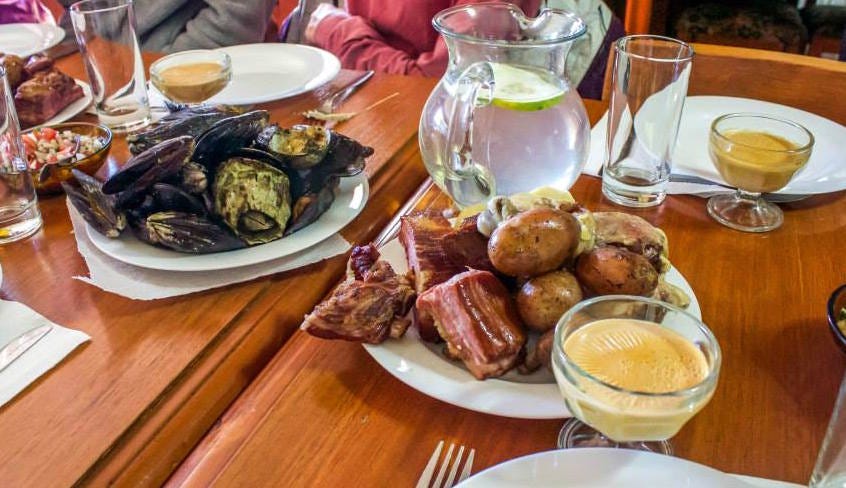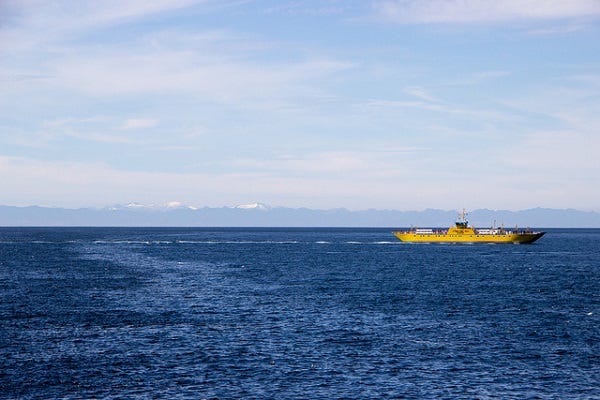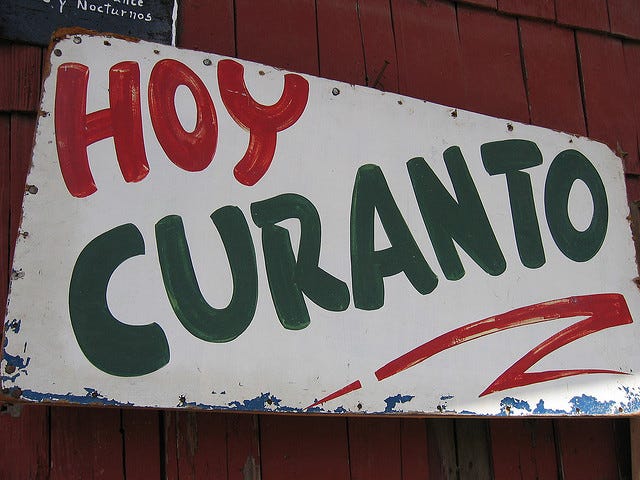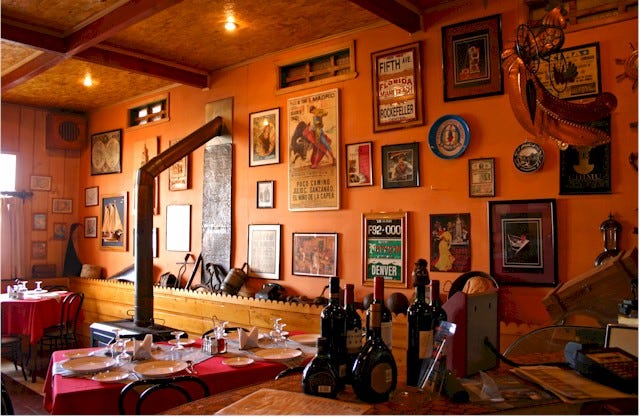The first time I saw the island of Chiloé was from the deck of cruise ship heading out of Puerto Montt and up the Chacao Channel. We’d spent much of the day on a bus, going to Petrohue Falls and around Lake Llanquihue in the shadow of Osorno, the Mount Fuji-like stratovolcano that towers over Chile’s Lake Region. The day had been wet and cloudy, the road to the falls unpaved, and the forest dense and mysterious. The sights we saw—a smallish waterfall cut into a lava bed, a dormant volcano and some homesteads around a lake—were not especially noteworthy.
Back on the ship, as we steamed northward, the sun broke through. Along the shore, just a mile to the left, were tiny horses and wooden houses, and the steeples of the churches of Chiloé, bathed in the soft sunlight of a golden hour. Ahead of the ship, I could see what I thought were small boats crossing back and forth, boxes stacked on their decks. As we drew nearer, and the boats grew in size, the small boxes were revealed to be buses and trucks. It was a magical transformation, from canoe to car ferry in the space of a few miles.
At that moment, standing on the deck of a cruise ship, on a calm stretch of water after a long wet day, I wanted to go to Chiloé more than I’ve ever wanted to go anywhere in the world. Had I been a better swimmer, I would have jumped overboard and swum ashore. But I didn't, and we sailed on to Valparaiso.
Unfortunately, it was another six years before I made it back to Chiloé, as part of a too-fast tour of the south of Chile, one whose ultimate goal was not leisurely dining in the Chilean backcountry, but vigorous hiking in the Patagonian mountains. It started in Puerto Montt, another long day on a bus that toured Petrohue Falls. This time the road to the falls was paved, the weather clear, and the forest mostly logged away. It was late summer, the river was lower, and the falls lacked the power and volume that had failed to impress me the first time around.
At the end of the afternoon, our bus drove onto one of the ferries, the deckhands cast off, and the boat slipped out into the Chacao Channel. I left the bus and climbed up onto a narrow observation platform just aft the deckhouse. A young woman from Colorado, a member of our group, stood next to me, repeating, "this is the strangest thing I've ever done," by which she meant being driven onto a boat in a bus, not traveling to an odd island at the opposite end of the globe. That this was the pinnacle of bizarreness in her life was a testament to her innocence and sweetness. May it always remain thus.
A half-hour later, we were driven off the boat and up the ramp onto Chiloé, the culmination of one of my profoundest travel desires. Of course, my other profound desire for Chiloé was to eat a curanto a hoyo, a “curanto from a hole”, a type of Chilote pit bake, a luau of shellfish, chicken, sausage, smoked pork, and potatoes in a variety of forms.
In a previous post, I said that our guide, Brit, believed that the curanto was probably brought to Chiloé by Polynesians in pre-Columbian antiquity. I was skeptical of that. The evidence of Polynesian contact with South America is still thin, although it's grown slightly fatter over the past decade with new DNA sequencing techniques. But I was also skeptical because cooking food in a hole in the ground with hot rocks is an ancient practice, one that is not only common in other parts of the world, but is common in South America, especially in Peru, where the pachamanca is a curanto by another name.
The blog Eating Chile, written by retired anthropologist James Stuart, gives a good brief accounting of the archeological evidence for ancient pit cooking.
Just when and where the practice of cooking in a pit with heated stones began, and how many times it was independently invented, is unclear, but the Chilotes were in good company. Alston V. Thoms, a Texas A&M archeologist who studies such things, tells us that the earliest European curanto-like finds (he calls them “cook-stone features”) date to the late Aurignacian (32–33,000 BP) in France. “They tended to be basin shaped, about 1.5 m in diameter, and filled with heat-fractured river cobbles.” Similar features are found on all continents, but their purpose is seldom clear. The best know recent (geologically speaking, i.e. with in the last 10,000 years or so) curantos are found in the Americas and in Polynesia.
The earliest found in North American date to around 10,500 BP and by around 9,000 BP they are common in the US Pacific North West, South East and North East where they were used to bake tubers and bulbs of wild plants.
Even if it could be proven that Polynesians reached Chile, it would be another, more difficult step to prove that curanto is not an independent invention of the Chilotes, but rather a gift of the Polynesians. Given that the earliest evidence of pit cooking found on Chiloé, from near Ancud at the Punto Quilo archeological site, dates from 4,000 BC, that would be hard to do. Polynesians were not Polynesians until a couple of millennia after that date.
Be that as it may, I was desperate to try curanto, and wanted to eat it almost as soon as we got off the bus and checked into the hotel. I did my duty, made sure everyone was settled, and then set out that evening to find a place that served it. I would not find curanto from a hole in the ground, but rather curanto a olla, "curanto from a pot", also known as pulmay.
Traditional curanto is a dish for dozens, if not hundreds. It begins with a hole dug a meter-and-a-half deep into the ground, filled with rocks, with a bonfire built on top of them. When the wood burns down sufficiently, and the rocks are hot enough, crates or burlap bags with shellfish—mussels, clams, giant barnacles (picorocos), and anything else that can be gathered from along the shore—are emptied onto the rocks. Then, the chicken, sausages, smoked pork and potatoes. On top of this are placed nalca, the giant leaves of the Chilean rhubarb plant. Then come the chapaleles and the milcaos, potato dumplings, one made with flour and mashed potatoes, and the other with grated potatoes and mashed potatoes. More nalca leaves and, sometimes, the burlap bags are piled on, sealing the curanto. It steams for an hour or two before the unveiling and eating.
Such feasts are too elaborate for a single tourist. They’re reserved for festive events, community celebrations, or when the tourists are thick on the ground and can be herded together to eat massive quantities.
Curanto a olla, or pulmay, is easier to prepare: shellfish are placed in a large pot with a copious amount of white wine. The sundry meats and potatoes are placed onto cabbage leaves, which are standing in for nalca, perhaps with layers of onions and peppers interwoven. A damp dishtowel with milcaos and chapaleles on top makes the final layer. The pot is sealed and placed on a low fire for an hour or so, then served with a cup, or bowl, of the broth at the bottom of the pot.
This was the dish I was aiming for that evening, a curanto a olla, a pulmay, fragrant with wine and shellfish. I found it just a block up from the port of Ancud, at a restaurant called Kuranton.
Kuranton is one of those places that feels like home, the sort of small cafe in which you could safely take all of your meals and never be discomfited, disappointed, or made to feel unwelcome. The middle-aged majordomo, a combination waiter/bartender/manager/maitre’d, welcomed us, seated us and tolerated our many questions with good humor.
“Can we split this dish between the children? Will there be enough? What is this? What wine do you recommend?”
As I’ve said, Chileans are hospitable. They’re taciturn in public, but they like to be helpful, and take pride in treating visitors well. (The song “Si vas para Chile“, a popular Chilean standard, is largely a paean to Chilean hospitality disguised as a love song.)
I was not disappointed in my curanto a olla. It was served with a bowl of the broth in which the meal was prepared, very tasty, and a plate heaped high with clams, mussels, meat and potatoes. The bread was good and the white wine, a decent sauvignon blanc, went down like fresh water. It was one of the most satisfying meals I’d had in Chile. The great discovery of the evening was not that clams and smoked pork go together like peanut butter and jelly, but that chapaleles, the Chilote potato dumplings, are delicious, especially when steamed over a pile of meat and seafood and wine.
Chiloé’s climate is similar to coastal Oregon or Washington, a temperate maritime rainforest sitting on the edge of a Pacific current that keeps the temperatures moderate and the seas rich. Because of this, potatoes grow like weeds. Nearly 100% of all the modern potato cultivars worldwide can be traced back to Chiloé, and the small farmers there still cultivate over 500 varieties of potato. Here’s 19th century French naturalist, Claude Gay, reporting on the potatoes of Chiloé
Though the soil of this archipelago is of inferior quality, the mild temperatures and humid climate are perfectly adapted for the cultivation of these roots, potatoes do very well and are the principal food of the inhabitants. The Chilotes take care to plant the varieties separately so that all do not come out the same. Some like the patirupñi, are bitter, bad tasting and serve only to fatten the animals; others like the huapa provide two harvests when planted twice a year, others are more or less appropriate for a good stew, or like the reina take the place of bread roasted in the ashes. Nevertheless, many varieties are frequently planted together and when harvested they are called chahuen. Certainly this kind of cultivation creates many other varieties, especially if the plants flower and bear seeds.
The importance of potatoes in the Chilote diet and their relative low cost, means that they're a part of every meal, usually in two or three different forms. The chapaleles, which are made with mashed potatoes, wheat flour, lard and sometimes chicharones, formed into patties and then steamed, baked or fried, are actually a way of stretching out wheat flour, and are sometimes served as a substitute for bread.
Aside from the food, the best part of the meal at Kuranton was the arrival of the owner. Halfway through the repast, the front door was flung open and in stepped a tall, broad-chested brawler, his head shaved clean, his thick forearms ropy with muscle. He was older than sin and more dangerous, more that 70 year old, but with the eye and energy of a much younger man. All he needed was corncob pipe and a sailor's hat cocked low over one eye. I don't know his story, but he was obviously a character. He may have been an actuary before becoming a restauranteur, but he carried himself like an old salt or a retired mercenary. And I was not disappointed when I later learned that his given names were Julio Caesar, for he was imperious to his staff—our friend the waiter snapped to—and a hale-fellow-well-met to the customers.
Kuranton was good enough that I went back the next night for a plate of razor clams and another glass of wine. I would have had the pulmay again, but early that afternoon our group had been led out into the countryside, to an agro-tourism farmhouse, where the family prepared an enormous curanto en hoyo, and I had gorged myself on smoked pork, sausage and mussels.

I do not wish to complain about a meal that was prepared by loving hands and served in a spirit of comity and generosity, but I found my restaurant meal, my curanto a olla at Kuraton, to be superior to the "authentic" farmstead curanto a hoyo. The problem with a pit curanto is that much of the shellfish—dropped directly onto the hot rocks and held there an hour—was overcooked. Not just over cooked, but charred on the edges and tough. Likewise, I missed that subtle broth, tasting of wine and the sea. Simply put, a good cook has more control over a pot on the stove than a pile of heated rocks.
If you visit Chiloé, you must have the true curanto a hoyo, for that is an experience not to be missed. But you will return to eat a curanto a olla, for that is a dish to be desired.
N.B. This was originally published at my old Eccentric Culinary website a couple years ago. It reminds me that it’s long since time for me to go back to South America.
Thanks for reading! If you’re not a subscriber, be sure to sure to sign up for twice-weekly updates sent directly into your email inbox.
An Eccentric Culinary History is pretty good description of the general content of this newsletter, eccentric pieces that reflect my odd and wide-ranging interests, primarily culinary and historical in nature. Take a look at the archives for a better sense of what you’ll get twice a week.
Thanks again for your attention and support, and I’ll see you on Monday with something new.








Such an interesting post. I too once went to Chiloé, once had an "authentic" cilantro in a restaurant that was nowhere near as colorful as this one you describe. The reaction of others in my party was interesting--just sort of "meh," a typical reaction I think when flavors are subtle but not intense. And of course, speaking of pit baking immediately reminded of our lobster/clam bakes in Maine, probably an equally ancient practice although decidedly not imported by Polynesian explorers.
Ok, we were planning to stop in Chiloe in December because of blue whales. This, like the last related post, has us salivating (we tend to give our taste buds a hefty vote in our travel planning!). How long would you recommend for the island--assuming a great deal of flexibility, no substantial cost limitations, and driving/hiking up from Port Arenas to Santiago?